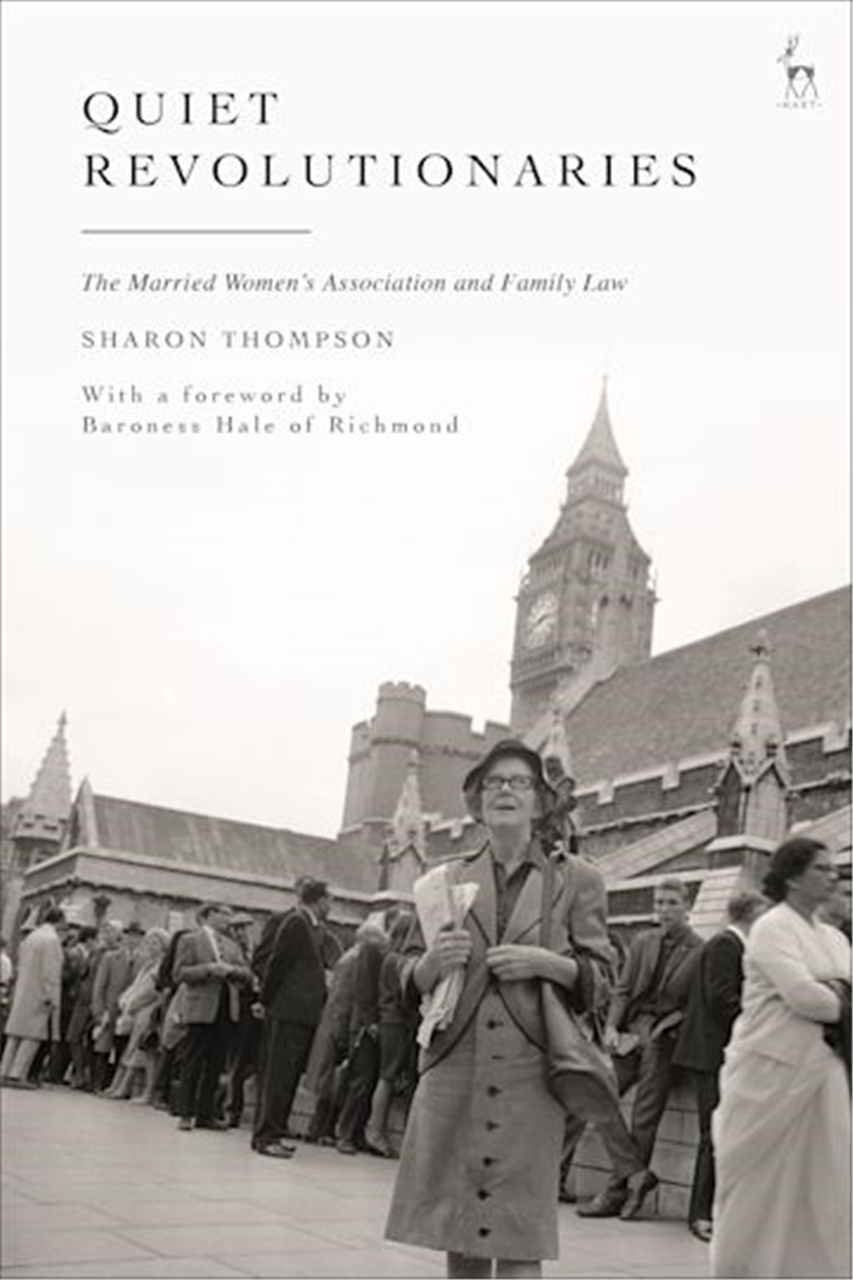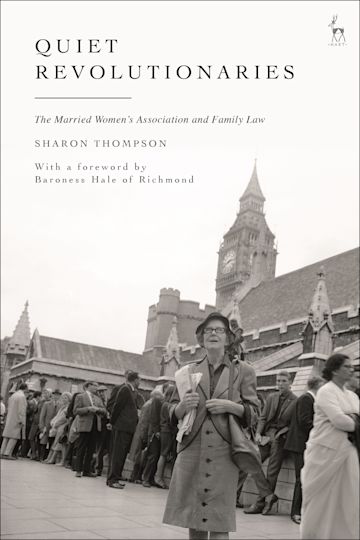
Book Review: Quiet Revolutionaries
Published: 27/03/2023 09:54

Quiet Revolutionaries: The Married Women’s Association and Family Law, Sharon Thompson (Hart Publishing, 2022)
Family lawyers today often talk of reform. In a relatively short period of time, we have seen fundamental changes to the landscape of family law including comprehensive no-fault divorce and mixed-sex civil partnerships. We are likely to welcome new reforms in the future too, such as changes to weddings law. With any luck, we might even get increased protections for cohabitants. In many ways these reforms are all about progression, modernisation and tailoring the law to the needs of a changing society. They are forward-looking, pioneering and seeking to break new ground.
By focusing on the future there is a natural temptation to dismiss the past. It might be asked whether reforms that took place last century offer any insights for campaigns today given the different societal and political contexts. After all, marriage and interpersonal relationships have changed, arguably for the better. But, as Sharon Thompson demonstrates in Quiet Revolutionaries, dismissing the past would be a mistake. In this wonderfully crafted book Thompson delves into the familiar past reforms in the field of family property and explores how incremental change is achieved. More importantly, the book provides the untold story of the protagonists and their sculpting of a movement that often is overlooked by conventional histories of family law.
The core focus of the book is on the Married Women’s Association, a quaintly-named organisation that Thompson admits brings to mind ‘tea parties and charity fundraisers’. But that could not be further from the truth. Formed in 1938, the mission of the organisation was to reform family property. It was borne out of the frustration experienced by wives that their contributions to the home were not valued in the same way as their husband’s. While the Married Women’s Property Acts of the Victorian era had enabled wives to own their property and keep their earnings, they did little to address the issue of genuine equality of the sexes. A gendered division of labour often resulted in the devaluation of both work in the home and childcare, which in turn created economic vulnerability upon divorce. It was a group of quiet revolutionaries that sought to challenge this position and achieve their ultimate goal of equal partnership in marriage.
This characterisation of the Association as ‘quiet but persistent’ is carefully unpicked by Thompson and the accounts of its work are juxtaposed against the more headline-grabbing revolutions ushered in by the suffragettes. Although the Association was composed of former suffragettes, the strategies adopted were arguably more subtle and involved ‘polite lobbying’. But this in no way denies the shrewd tactics adopted by these women and, as Thompson notes, when needed there were ‘dramatic confrontations with politicians, civil servants and Law Commissioners’. The Association’s work was not easy too – Thompson observes that the Association members’ commitment, strategizing and long-hours of work were often met with ‘derision, ridicule, wilful ignorance and reactionary backlash’. Indeed, the depiction of members of the Association by the press oscillated between calling them ‘fragile little women’ and ‘threatening man-haters’.
By exploring the tireless work of the Association, Thompson skilfully places women back into the historical record. Women are not the afterthought in this book or painted simplistically as the victims of an unjust patriarchal society. Instead, Thompson allows us to see their individual personalities, their strengths and, at the same time, their vulnerabilities. The public and private lives of powerful public figures in the organisation such as Edith Summerskill MP, Vera Brittain, Dora Russell, Helena Normanton and Juanita Frances are exposed and brought to life. For example, the prologue reveals an illuminating exchange between the Association’s founder Juanita Frances and her husband as to which political party she should vote for in the 1935 General Election. After rejecting her husband’s somewhat blithe and simplistic advice, Frances reads all she could find on the suffragettes and educated herself in politics so that she might exercise her right to vote effectively. She went from a political novice to a leading feminist campaigner of the day. It is these vignettes, sourced through meticulous archival research, that allow Thompson to provide fresh insights into the easily overlooked daily lives of women leading the Association.
Another theme running through this book is that reform is not a singular act or moment of triumph. Rather it is a process and continuing conversation. Progress, as Thompson reminds us, is not always inevitable and for all the successes of the Association, there were crushing failures too. Their equal partnership Bill never came to fruition and throughout the time the Association was active there were ‘few major legislative reforms’. But the Association succeeded with a series of small victories in the 1950s and 1960s relating to maintenance, housekeeping allowances and matrimonial home rights. While these have been overshadowed by the Divorce Reform Act 1969 and the Matrimonial Proceedings and Property Act 1970, they nevertheless remain significant milestones in the Association’s history. They remind us that effective reform need not always be fundamental, structural change to the law’s architecture but can take the form of a gradual erosion or chipping away of the law’s foundations. Thompson teases out this theme throughout the book and highlights a perceptive observation by Vice President of the Association, Teresa Billington-Greig in 1958 that:
‘Reform movements are like builders; they set out to erect structures in which human beings can live better lives but there are few of them which can begin their constructive work at once because of the state of the site on which they have to build.’
Much of this building work requires an appreciation that reform can be measured differently by different people. It does not necessarily mean legislation or a landmark case but can involve shifting societal perspectives, reorientating public debates and injecting a new language into our vocabulary. For example, in 1964 the Association recognised the success of its reform activities by noting that, ‘we have created by propaganda and agitation a public opinion that marriage is a partnership’.
The structure of the book is innovative and engaging. It is not a terse chronological recounting of the Association’s history from inception to demise. Rather, Thompson intersperses the chapters with interludes or spotlights on specific key protagonists, moments and developments. This provides a vibrancy to the book and opens it up to a wider audience. They ensure that the book will be of interest not only to family lawyers but also to a wide range of scholars, especially those interested in the movement for women’s equality. One rather striking example is an interlude exploring Lord Denning’s views of the Association, and of women more generally. Thompson highlights his views on equality and his belief that by 1950 the wife had become the ‘spoilt darling of the law’ and the husband ‘the patient pack-horse’. The reaction of the Association, and its refutation of this claim, is then revealed. Interestingly, this exchange exposed some of the fault lines in the Association’s membership and it prompted a realisation that maintaining public support for its aims required compromise, regrouping and the repackaging of its central message.
Quiet Revolutionaries is a fantastic book that should be read by legal historians, practitioners and anyone interested in how legal change is achieved. Thompson deserves praise for reanimating the lives of women that in muted, understated and unconventional ways fundamentally changed the public conversation around property holding in marriage. Drawing upon rich insights from archival and empirical research, this book reveals that ‘the MWA’s story is a microcosm of feminist legal activism’. This observation is important as, despite the House of Lords’ decision in White v White and the sculpting of the evolved discretion of Part II of the Matrimonial Causes Act 1973 by the courts, it is arguable that genuine equality has not yet been achieved, and that this feminist activism is still needed. Quiet Revolutionaries provides a new way of thinking about that activism and how ‘success’ might be measured for reform projects in family law today.









